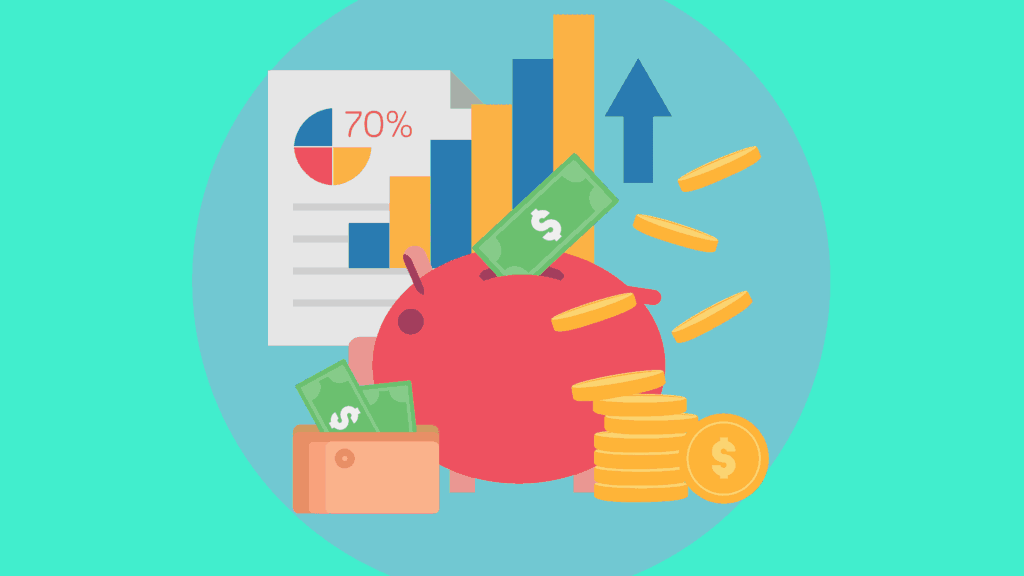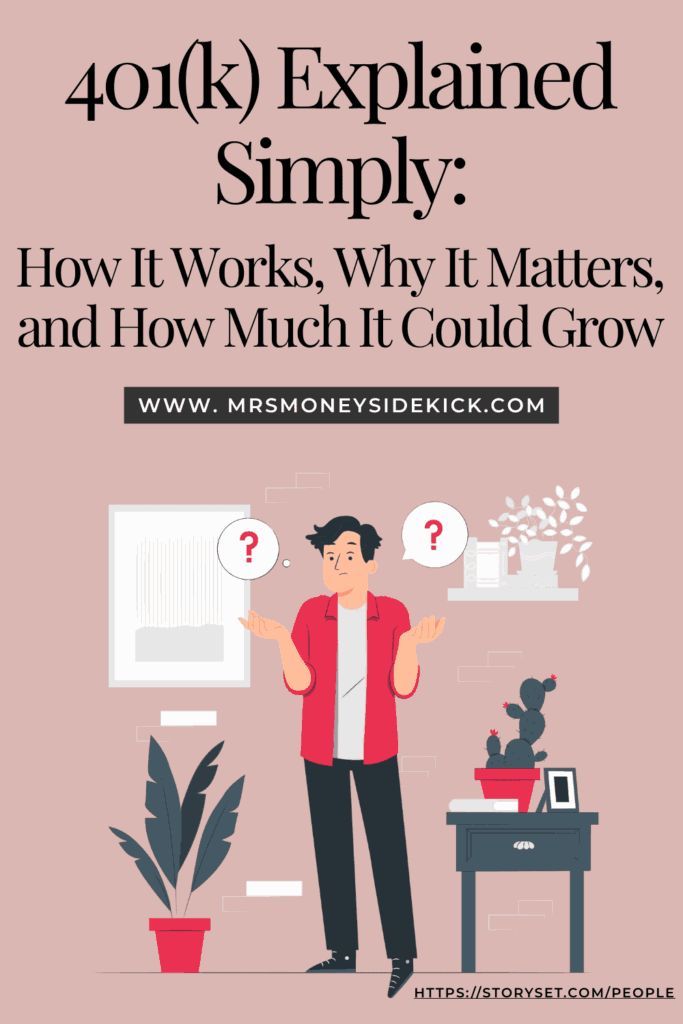401(k) Explained Simply: How It Works, Why It Matters, and How Much It Could Grow
When you start a new job and hear about the 401(k) plan, it might seem confusing at first. But don’t worry, here’s your 401(k) explained simply, with clear, easy-to-understand answers and no complicated jargon.
What Is a 401(k)?
Let’s start with the basics. A 401(k) is a type of retirement savings account offered by many employers. You contribute a percentage of your paycheck before taxes, and the money is invested so it can grow over time.
401(k) explained simply: It’s a way to automatically save for retirement, reduce your taxable income now, and possibly get extra money from your employer as a match. Since it’s meant for retirement, you generally can’t withdraw the money before age 59½ without a 10% penalty — and even after that, you’ll still pay regular income taxes on any amount you take out.
Why Was the 401(k) Created?
In the late 1970s, traditional pensions were becoming too expensive for companies to maintain. The 401(k) was created to let employees take more control over their retirement savings and employers could offer matching contributions without managing full pensions. It became a powerful benefit when employers added matching contributions to encourage employees to contribute and help them grow their money grow even faster.
Why It Matters (Even If Retirement Feels Forever Away)
You might think: “I’m young. Retirement is decades away. Why start now?”
Here’s why:
- You’re leaving free money on the table if you skip your employer match.
- Compound interest needs time. The earlier you start, the less you need to save overall.
- You can’t count on pensions or Social Security alone. Your 401(k) is your safety net.
- Tax benefits:
- Contributions are pre-tax, so you reduce your taxable income now.
- Your investments grow tax-deferred.
- You pay taxes when you withdraw in retirement, when your income might be lower.

How Does a 401(k) Work? (Real Example)
Let’s walk through a real example. Imagine you earn $52,000 per year, or $2,000 gross every two weeks.
Your employer offers a 50% match up to 6% of your salary. What that means is:
- You contribute 6% of $2,000 = $120 (pre-tax)
- Your employer matches half = $60
- Total added to your 401(k) that payday = $180
That’s $4,680 added every year, without you lifting a finger beyond your paycheck contribution.
401(k) explained simply: Every paycheck, you’re not just saving your own money, your company is giving you bonus money too! The earlier you start, the more powerful it becomes.
Compound Growth Example (Based on $52K Salary)
Let’s assume:
- You’re 30 years old
- You make $2,000 per bi-weekly paycheck ($52,000 per year)
- You contribute 6%
- Your employer matches 50% up to 6%
- You get a 1% raise annually
- You invest in funds earning the average 7% per year
- You stay invested until age 59½
- You never withdraw, and you consistently invest for the full period
Here’s how that looks:
| Year | Your Contributions | Employer Match | Total Contributions | Growth Earned | Estimated Total w/ Growth |
| 1 | $3,120 | $1,560 | $4,680 | $0 | $4,680 |
| 5 | $15,600 | $7,800 | $23,400 | $3,513.46 | $26,913.46 |
| 10 | $31,200 | $15,600 | $46,800 | $17,860.98 | $64,660.98 |
| 20 | $62,000 | $31,200 | $93,600 | $98,258.90 | $191,858.90 |
| 30 | $93,600 | $46,800 | $140,400 | $301,676.48 | $442,076.48 |
401(k) explained simply: Over 30 years, contributing just $4,680 per year to your 401(k) (including employer match) can grow to over $442,000 thanks to compound interest, even though you only contributed $140,400 yourself. That’s the power of starting early and staying consistent!
How Much Can You Contribute?
In 2025, you can contribute up to $23,000 to your 401(k) if you’re under age 50. If you’re 50 or older, you’re allowed an additional $7,500 in catch-up contributions, for a total of $30,500.
You don’t have to contribute the maximum to make real progress. Even just contributing enough to get your full employer match is a huge win. But if you can afford to go beyond that? Even better.
401(k) explained simply: the more you contribute now, the more time your money has to grow, and the less pressure Future You will feel. A small increase, like going from 6% to 10% of your paycheck, can add up to hundreds of thousands of dollars by retirement thanks to compound growth.
✅ Pro-tip: Every time you get a raise, try bumping up your 401(k) contribution by that percentage. You probably won’t notice the difference in your take-home pay, but your retirement account will thank you. Every extra dollar you contribute now has the power to grow and multiply for decades thanks to compound interest.
What Happens Next? Don’t Forget to Invest It!
One mistake many people make is assuming that once the money is in their 401(k), it automatically grows.
Wrong.
Saving is step one. Investing your savings is step two.
If you don’t actively choose your investments, your contributions could sit in a low-interest cash fund, earning very little. Over time, inflation will quietly reduce their value.
What Investment Options Are Usually Offered?
Depending on your employer’s plan, you might see:
- Target Date Funds: One-click option based on your retirement year (ex: 2065 Fund). It adjusts automatically as you get closer to retirement.
- Index Funds: Simple, low-cost funds that track things like the S&P 500.
- Mutual Funds: Professionally managed, but often have higher fees.
- Bond funds or cash equivalents: Lower risk but lower growth.
- Company Stock: Some plans offer your employer’s stock — but don’t put all your eggs in one basket.
✅ Pro-tip: If you’re not sure where to start, go with something simple like a target date fund or an index fund to start putting your money to work. Target date funds automatically adjust your risk as you get closer to retirement. We’ll cover investing options in more detail later — but for now, just remember: saving is a great first step, but you also need to invest those savings for real growth.
What If I Didn’t Start Yet?

You’re not alone.
While my husband and I were dating, we hadn’t talked much about finances yet, I found out that he hadn’t contributed to a 401(k) for five years. FIVE. YEARS.
No one explained it to him and he didn’t bother to look into it. I gave him such a hard time (lovingly, of course). That was thousands of dollars missed out on, from his own savings and the free match from his job.
Even if you’re starting late, it’s never too late to start! This is why I’m so passionate about 401(k) explained simply, I want you to grab the opportunities that are waiting for you.
✅ Pro-tip: Start now. Start now, even if you can’t contribute enough to get the full employer match yet. It’s okay — that can be a future goal to work toward. What matters most is building the habit and getting started.
Can You Take Money Out Early?
Yes, but not without consequences.
401(k) is for retirement, so early withdrawals (before age 59½) come with a 10% penalty, plus you still owe income taxes on the amount.
Exceptions exist, such as:
- Hardship withdrawals (if your plan allows it)
- Qualified public safety workers (can withdraw at age 50+)
- Rule of 55: If you leave your job (quit, retire, or are laid off) at age 55 or older, you can withdraw from your 401(k) without the 10% penalty (but taxes still apply)
- 401(k) loan: Some plans let you borrow from your 401(k). You’ll repay yourself with interest (within 5 years), but there are risks if you leave your job before paying it back the remaining balance is typically due in full within a short period (usually 60 days).
Final Thoughts:
Your 401(k) is one of the smartest moves you can make. If you only take one thing away from this 401(k) explained simply guide, it’s this:
Start your 401(k) as early as possible, even if it’s just a little.
You’re not just saving money — you’re claiming your future freedom, peace of mind, and the foundation for a future that doesn’t leave you stressed about retirement.
401(k) explained simply: it’s an employer-backed retirement account that uses pre-tax money and long-term investing to help you grow your wealth. The earlier you start, the more time you give compound interest to work its magic.
Quick Tips to Maximize Your 401(k)
- Always contribute enough to get the full employer match (free money!).
- Set your contributions to increase automatically whenever you get a raise.
- Invest the money inside your 401(k): don’t leave it sitting in cash!
- Avoid withdrawing early: don’t pull it out early unless it’s an absolute emergency (penalties and taxes can hurt your progress).
Don’t Forget to Check Your Old 401(k)s
If you’ve changed jobs in the past and left a 401(k) behind, now’s the time to take action. Don’t leave your retirement money sitting at your old company.
You can roll it over into:
- A traditional IRA (if it was a pre-tax 401(k))
- A Roth IRA (if it was a Roth 401(k))
- Or even into your new employer’s 401(k) if they allow it
This keeps your money in your hands and growing instead of being forgotten and unmanaged.
Bottom Line
Starting your 401(k), contributing regularly, and keeping tabs on where your retirement savings live is one of the smartest, most empowering money moves you can make.
You’ve got this and Future You will be so glad you did.
On your side,
Mrs. Money Sidekick
P.S. Want to learn more about money essentials? Check out these helpful posts.
Featured Image People illustrations by Storyset









2 Comments